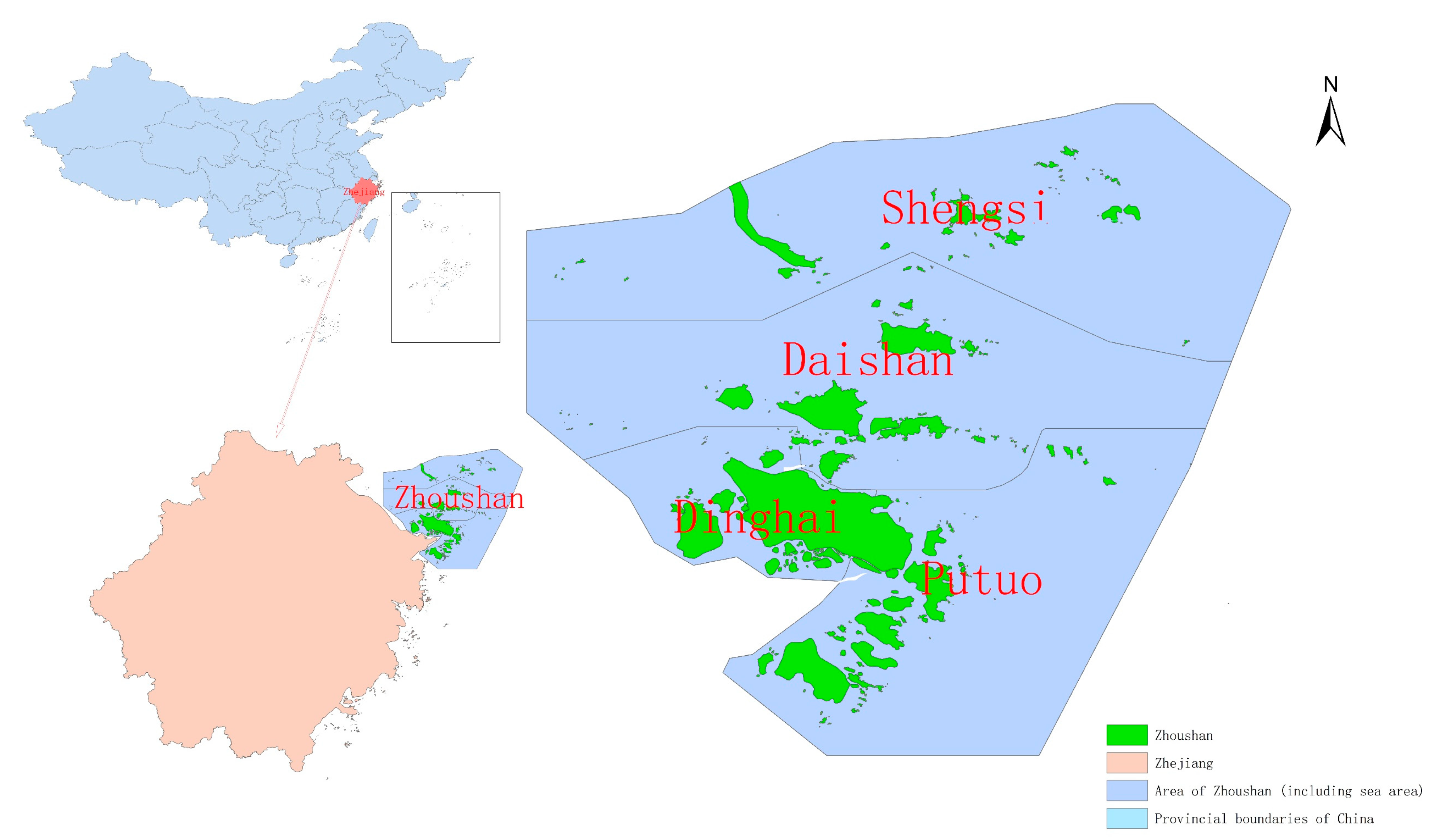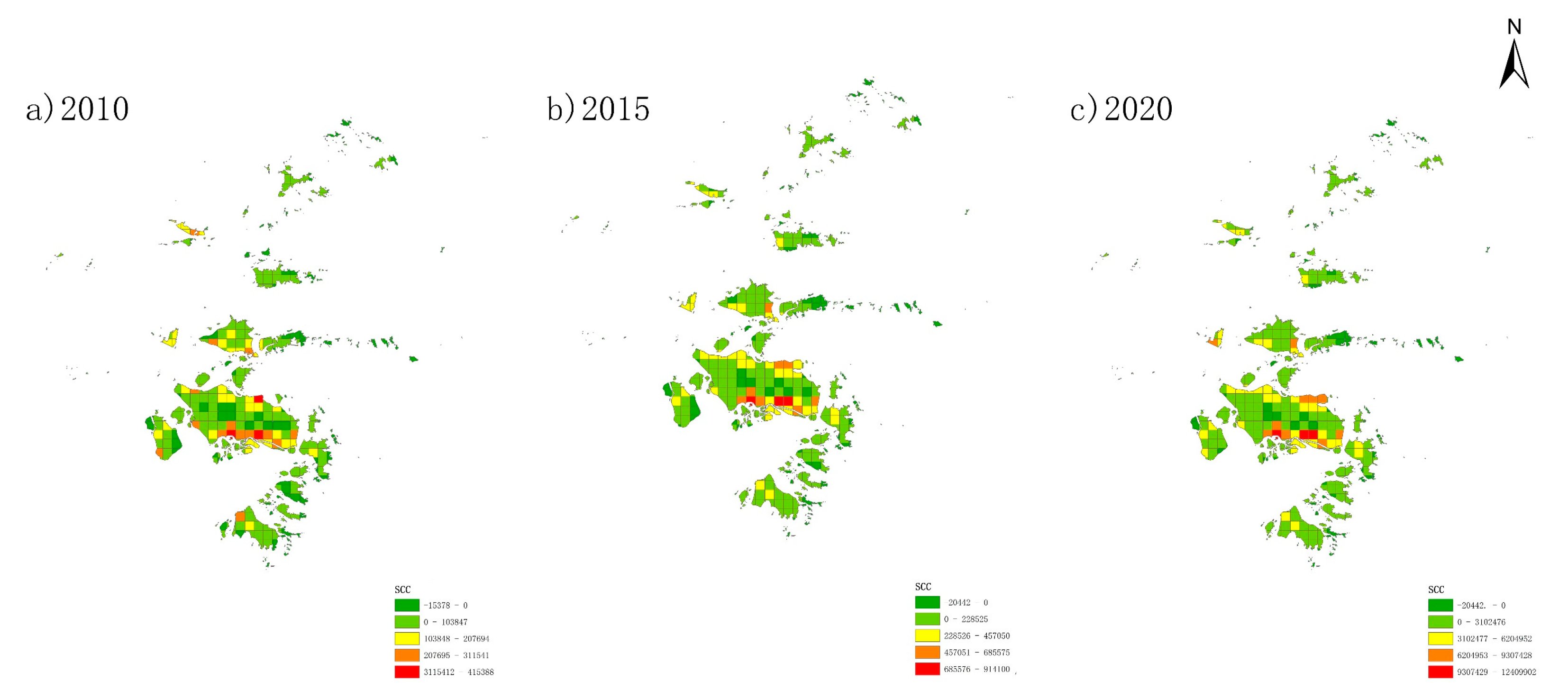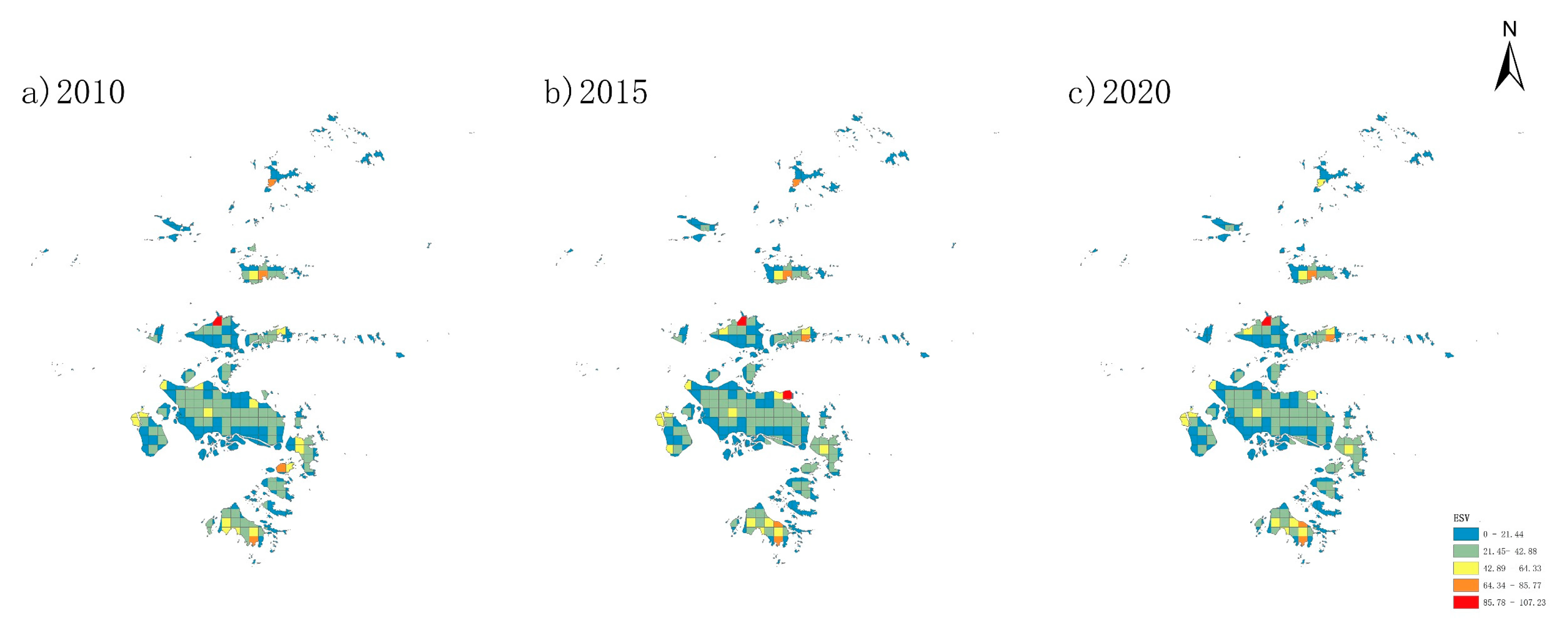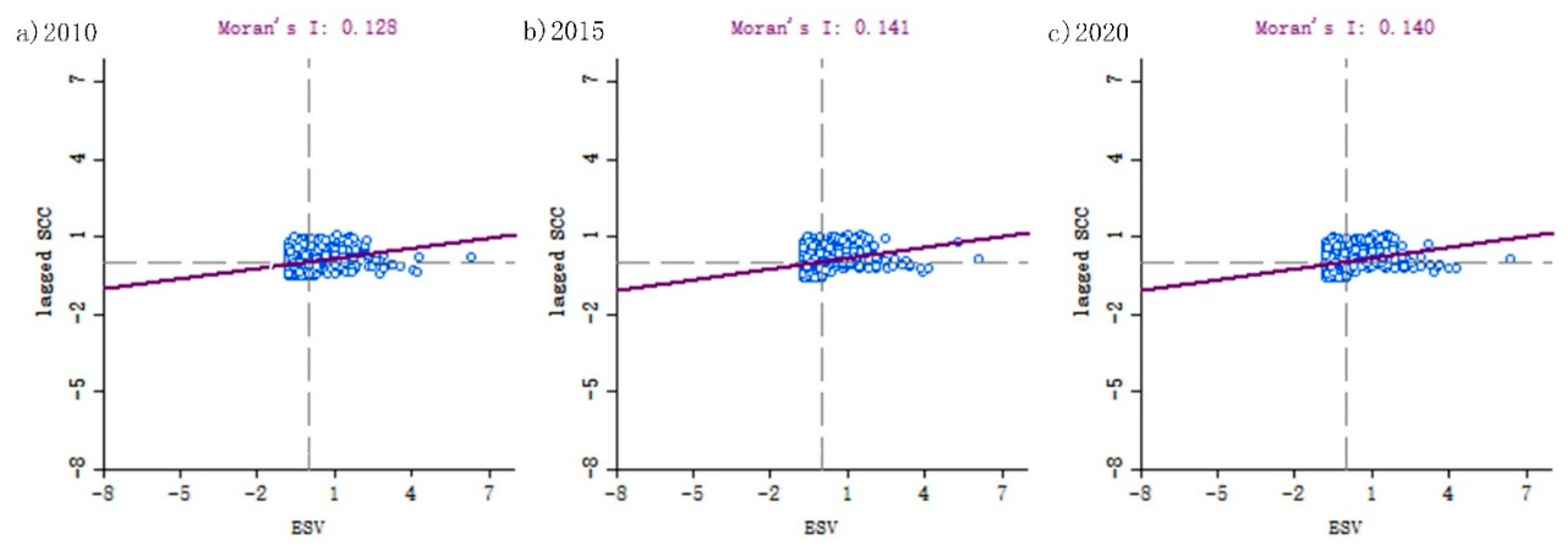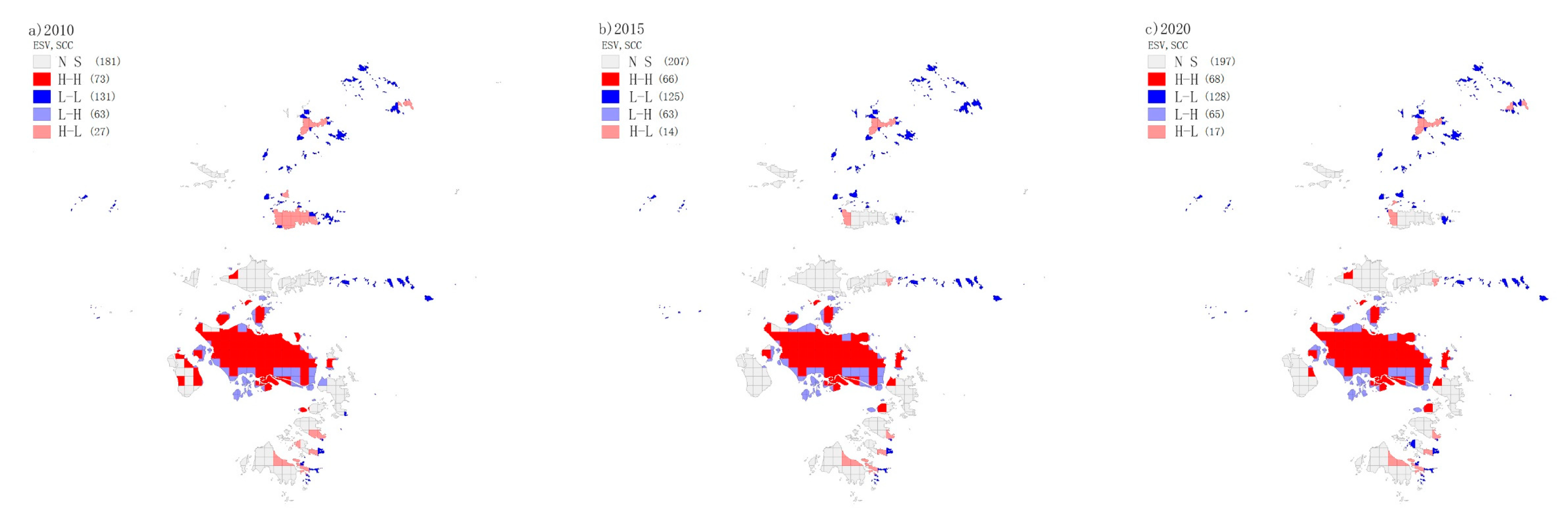1. Introduction
The escalating trajectory of carbon emissions, leading to global warming, has garnered widespread concern, compelling the international community to prioritize the development of a green and low-carbon economy as a consensus strategy to effectively address and mitigate climate change[
1]. Predominantly originating from human activities, greenhouse gas emissions pose a considerable threat. In comparison to carbon emissions stemming from industrial production and the combustion of fossil fuels, the introduction of land-use change injects heightened uncertainty into the carbon emission equation[
2]. The Intergovernmental Panel on Climate Change's (IPCC) report on climate change and land underscores that all scenarios restraining global warming to 1.5 degrees Celsius hinge significantly on methodologies that effectively mitigate land-use change and facilitate the decarbonization of the economy[
3]. Beyond the direct impact on carbon emissions, land-use change significantly disrupts the stability of terrestrial ecosystems by altering their structure and function[
4]. This alteration is pivotal for maintaining ecosystem services, which play a critical role in ecological equilibrium[
5]. Within the realm of land-use optimization, a primary objective is to maximize environmental benefits. The valuation of ecosystem services stands out as a crucial metric, providing a quantitative measure of these environmental benefits[
6]. Emphasizing the explicit comparison of economic costs and environmental benefits, economists play a crucial role in shaping sustainable policies[
7]. The Social Cost of Carbon (SCC), estimating the economic loss incurred by emitting an additional tonne of carbon dioxide, serves as a valuable tool for evaluating environmental policies and green investment projects[
8]. The joint valuation of ecosystem service values and carbon emissions establishes the foundational basis for national and governmental management decisions. This encompasses endeavors to ensure human well-being and implement measures for mitigating and adapting to climate change[
9]. In the context of China's dual carbon policy and simultaneous emphasis on enhancing the ecological environment, an in-depth exploration of the spatial patterns of carbon emissions and ecosystem service values assumes paramount importance. This investigation becomes pivotal in addressing the formidable challenge of harmonizing economic growth with environmental protection within the trajectory of societal development.
Ecosystem services encompass the diverse range of benefits that humans derive directly or indirectly from the environment[
10]. The Millennium Ecosystem Assessment report systematically categorizes these services into supporting, regulating, provisioning, and cultural functions[
11]. The valuation of ecosystem services involves a meticulous quantification of the benefits accruing to humans from these services, thereby providing a robust foundation for informed decision-making[
12]. Various methodologies are employed to estimate the value of ecosystem services, including energy value analysis, ecological space valuation, material quality valuation, and value quantity valuation[
13]. Notably, the value quantity evaluation method, grounded in the area of each land use type and its corresponding factor value coefficient, has gained widespread application due to its ease of data collection and low estimation cost[
14]. The ESV estimation model introduced by Costanza et al. in 1997 has garnered extensive recognition and usage[
15]. Subsequently, Xie et al. revised ecosystem service types, aligning them with China's ecological characteristics, and enhanced the ESV equivalent factor for various land use types[
16]. Given China's considerable geographical diversity and complex ecosystems, the application of ESV assessment necessitates a comprehensive consideration of the scale, natural environment, and socio-economic conditions of the study area. This demands the adjustment of ESV equivalent factors per unit area to establish a bespoke ESV assessment system[
17].
Land-use carbon emissions encompass the intricate processes, activities, and mechanisms through which land, altered by the human production activities it supports, releases carbon dioxide into the atmosphere. This multifaceted process involves both direct and indirect carbon emissions[
2]. Land-use change directly influences the carbon balance of terrestrial ecosystems, subsequently impacting regional carbon emission levels[
18], and exerting a substantial influence on global carbon cycling processes[
19]. Various methodologies are employed to account for carbon emissions, including the land inventory method, mechanism model simulation method, and carbon emission coefficient method. Among these, the emission coefficient method stands out for its simplicity and broad applicability across different scales[
20]. The assessment of land-use carbon emissions in the study area not only serves as a scientific reference for mitigating global warming but also holds practical value for adaptive planning and management of land use[
21]. The optimization of land-use carbon emissions and its regulated control [
22] , along with regulation [
23], carry crucial practical significance.
The impacts of land use change on carbon emissions and ecosystem service values have undergone extensive scrutiny and validation [
24,
25,
26]. Current studies consistently integrate both aspects, providing empirical support for sustainable environmental management. For instance, Soumik Saha et al.[
27] conducted a comprehensive assessment in the Chota Nagpur Plateau (India), quantifying carbon stocks, evaluating the status of ecosystem service values, and measuring total primary productivity. Similarly, Chen et al. [
28] delved into the spatial and temporal variations in carbon emissions and ecosystem service values induced by land use cover changes within the Chengdu-Chongqing urban agglomeration in China. Scholars have explored both quantitative [
29] and spatial[
30] relationships between carbon emissions based on land use and the value of ecosystem services. Notably, du et al. [
31] calculated and analyzed the ecological and environmental impacts of land use change in Hangzhou, encompassing ESV and carbon emissions. In the context of the Guanzhong Plain urban agglomeration in China from 2000 to 2020, Yang et al. [
32] evaluated the carbon emission intensity and ESV intensity, revealing a significant negative spatial correlation [
33]. The utilization of the SCC to depict the correlation between carbon emissions and ESV is compelling and comparable, as both methods involve quantitative evaluation from a monetary value perspective[
24]. The SCC accounting serves as pivotal evidence for future climate policies and optimizing carbon emissions structures [
34]. For instance, Wilfried Rickels et al. [
35] estimated a historical time series of the social cost of carbon, assessing the global wealth reduction attributable to individual countries' CO2 emissions from fossil fuels and industrial processes from 1950 to 2018. While payments for carbon and ecosystem services have been assessed to compensate for the loss of livestock income due to reduced grazing regimes and provide carbon sequestration and other benefits[
36], there exists a dearth of studies exploring the relationship between carbon emissions and the value of ecosystem services in island ecosystems.
The island ecosystem, positioned at the juncture of the ocean and land, represents a distinctive and intricate geographical region. Marked by a simplified ecological structure, constrained land resources, diminished species richness, and inherent ecological fragility[
37], island ecosystems nonetheless exert substantial influence on the global carbon cycle[
38]. Presently, a noticeable gap exists in the scholarly landscape regarding comprehensive assessments encompassing both carbon emissions[
39] and ESV[
40,
41] specific to island ecosystems.
This study seeks to elucidate the spatial and temporal dynamics and distribution patterns of ESV and SCC within island ecosystems, as influenced by land use changes. The overarching objective is to contribute valuable insights supporting the formulation and implementation of integrated policies for both land use management and carbon emission control. Utilizing the Zhoushan Islands as a case study, we systematically quantify ESV and SCC across the temporal spectrum from 2010 to 2020. Subsequently, we meticulously analyze their spatial and temporal distribution characteristics and evolution patterns. The investigation extends to a spatial correlation analysis of ESV and SCC at the grid level, aiming to ascertain the existence of a spatial correlation relationship between the two metrics. This analysis further explores their spatial interaction characteristics and local clustering patterns. The findings of this research hold substantial theoretical significance and offer practical implications for advancing objectives related to low-carbon initiatives, green practices, and the pursuit of high-quality regional development.
3. Results
3.1. Spatiotemporal Evolution of Land Use Structure in Zhoushan Archipelago
The area of each land-use type was systematically recorded, as detailed in
Table 3. The unit is hectare.
The results of our land use classification reveal a distinct trend in the total land area of the Zhoushan Archipelago from 2010 to 2015, primarily attributed to human reclamation activities. Subsequently, there was a modest reduction in area from 2015 to 2020, with relatively minor changes. Specifically, the areas designated for forest and water experienced a gradual annual decline, while the land allocated for construction witnessed a consistent increase. Human reclamation activities on mudflats influenced an overall expansion in both grassland and mudflat areas. In contrast, other land use types exhibited relatively stable patterns, characterized by small fluctuations in their respective contribution rates.
3.2. Spatiotemporal Evolution of SCC
By utilizing the area of each land-use type and carbon emission coefficients specific to the Zhoushan Archipelago, we calculated carbon emissions for each land type during the period 2010–2020 using formulas (1) and (2), as detailed in
Table 4. Subsequently, in accordance with Equation (3), carbon emissions were used to determine the SCC. The SCC values were categorized into five levels, representing a spectrum from low to high, and the results showcasing its spatial and temporal variations are illustrated in
Figure 2.
The findings on carbon emissions reveal a consistent upward trajectory in net carbon emissions throughout Zhoushan Archipelago from 2010 to 2020, indicating an overall increase. The period spanning 2010 to 2015 experienced a substantial surge in net carbon emissions, escalating from 53.21 × 104 t to 1604.01 × 104 t by 2020. The growth rate moderated between 2015 and 2020. Carbon sources exhibited a parallel trend to net carbon emissions, accompanied by a slight decline in carbon sinks. Examining the composition of carbon sources, emissions from construction land surged from 1,057.91×104 t to 4,125.12 × 104 t, emerging as the primary carbon source. This surge was primarily attributed to the rapid urbanization and industrialization of Zhoushan Archipelago post-2010, leading to a substantial increase in emissions from construction land. Per capita carbon emissions from construction land, indicative of carbon emission intensity and regional energy consumption structure, witnessed a pronounced upswing since 2015. Per capita carbon emissions from construction land for the respective years were 22.21, 40.79, and 546.13 t/ha. Examining the composition of carbon sinks, forests emerged as the predominant carbon sink, closely followed by mudflats. The distribution across different land categories remained relatively stable.
Figure 3 illustrates significant spatiotemporal variations in the carbon emission intensity of land use in the urban cluster from 2010 to 2015. The lowest intensity manifests as a carbon sink, primarily situated in the central area of Zhoushan Island, the coastal fringe of larger islands, and some isolated small islands distanced from the mainland. Conversely, all other levels manifest as carbon sources. Regions with higher social cost intensity of carbon emissions are concentrated in Zhoushan Island, Daishan Island, Liuhang Island, and Jintang Township – regions characterized by substantial land areas and concentrated populations. Yuoshan Island, situated to the left of Daishan Island, exemplifies a typical industrial island, witnessing a steady increase in carbon emissions over the study period. Peripheral scattered islands, distant from the mainland, exhibit low carbon emissions, attributed to their smaller size, challenging development prospects, and sparse human activities.
3.3. Spatiotemporal Evolution of Ecosystem Service Value
Employing Formula (9), we computed the spatiotemporal changes in ESV across Zhoushan Archipelago from 2010 to 2020, considering the area of each land type and its corresponding ESV, as detailed in
Table 5. The temporal shifts in ESV, categorized by land-use type, are outlined in
Table 6. ESV intensity changes were stratified into five levels, and the outcomes are depicted in
Figure 3.
The findings indicate a dynamic trend in the total ESV within Zhoushan Archipelago from 2010 to 2020, characterized by an initial ascent followed by a subsequent decline. Overall, a diminishing trend is observed, with a decrease from 5565.04 million yuan in 2010 to 5484.88 million yuan in 2020, representing a 1.5% reduction. In terms of individual ESV functionalities, hydrological regulation and climate regulation emerged as principal contributors, jointly constituting 57% of the total. Climate regulation experienced an increase, while hydrological regulation witnessed a decrease, with other functions remaining relatively stable. Analyzing different land-use types, woodland and watershed proved to be the primary contributors to ESV, collectively accounting for 83% of the total, closely followed by mudflat. Grassland exhibited an increase, watershed experienced a decrease, and other types fluctuated within a 1% range.
Figure 4 illustrates slight spatial and temporal variations in ESV intensity across Zhoushan Archipelago during the study period, predominantly reflecting an overall decreasing trend. Regions with low ESV values are primarily distributed in coastal areas near large islands, which coincide with aggregations of built-up areas. Conversely, regions with high ESV values are concentrated in areas abundant with forest, water, and mudflat expanses, aligning with the distribution of different land-use types and their respective ESV contribution rates.
3.4. Spatial Correlation Analysis between ESV and SCC
Utilizing Geoda software, a bivariate global Moran's I index analysis was executed for both the ESV and SCC of carbon emissions in Zhoushan Archipelago from 2010 to 2020. The analysis comprised 999 randomizations for testing, and the results are detailed in
Table 7. The Moran scatterplot, presented in
Figure 4, delineates each quadrant as High-High (H-H), Low-High (L-H), Low-Low (L-L), and High-Low (H-L) clustering types. Additionally, bivariate local Moran's I analysis was employed to scrutinize the spatial clustering relationship within individual grid cells for ESV intensity and social cost intensity of carbon emissions, as depicted in
Figure 5.
The results reveal correlation coefficients between ESV and SCC in Zhoushan Archipelago from 2010 to 2020 of 0.142, 0.136, and 0.134, respectively. The positive Moran's I value, with p-values < 0.01 and z-values > 2.58, indicates a statistically significant spatial correlation between ESV and SCC at a 99% confidence level. Surprisingly, regions with high ESV tend to exhibit high SCC, which contradicts conventional expectations where high ESV correlates with low SCC. To better understand this result, a bivariate local analysis was conducted, as depicted in
Figure 5. The analysis reveals clustering in the first and third quadrants, indicating that H-H and L-L types are spatially clustered, while L-H and H-L types are dispersed.
Figure 6 illustrates minimal changes in clustering types in Zhoushan Archipelago over time. During the study period, the number of grids in H-L and L-H increased, while H-H and L-L grids decreased. H-H and L-L regions exhibit a positive correlation between ESV and SCC, while L-H and H-L regions display a negative correlation. The proportion of networks with a positive correlation is 24% higher than those with a negative correlation. H-H is predominantly concentrated in economically active regions with significant carbon emissions, such as Zhoushan Island, Putuoshan Island, and Daishan Island. These areas prioritize environmental protection, resulting in higher ESV. Islands like Shengsi Archipelago and Dongji Archipelago, characterized by their distance from the mainland, limited human activities, and lower carbon emissions, exhibit L-L characteristics. Meanwhile, L-H is distributed in areas where construction land is accumulating on Zhoushan Island, reflecting the impact of urbanization on ecological resources and resulting in lower ESV and higher carbon emissions. H-L is mainly found on Qushan Island, some islands in Shengsi County, and certain islands in the eastern part of Putuo District. Local correlations in other regions are not statistically significant (NS).
4. Discussion
The analysis of land use changes reveals that, during the study period, alterations in the total land area were primarily propelled by reclamation and the development of the Wadden Sea. The growth of land resources on the islands remained limited overall, with construction land steadily increasing while other land types, like farmland, experienced proportional decreases. The development of cross-sea bridges in Zhoushan after 2010 significantly accelerated island development, contributing to rapid economic growth, urbanization, and industrialization. These factors led to heightened human activities on built-up areas, resulting in increased carbon emissions. From 2010 to 2020, Zhoushan's net carbon emissions rose by 1550.8 × 104 t, and the SCC surged by 2452%. Despite this, the total ESV of Zhoushan Archipelago exhibited a slight downward trend during the study period, with a marginal change of 1.5%. This trend is attributed to the high ESV of land types such as forests and water bodies, which possess robust ecological compensation capabilities. The importance of mudflats, a characteristic land type of islands, should not be overlooked. Therefore, future development strategies should prioritize the protection of forests, water bodies, and mudflats to enhance regional ESV and foster high-quality development.
This study was motivated by two main considerations. Firstly, previous research has often treated carbon emissions and ecosystem service values as separate evaluation units for assessing environmental benefits, with limited exploration of their correlation[
28,
29,
31,
59]. Secondly, scholarly attention has predominantly focused on the provincial level or higher administrative divisions, with coastal and island areas receiving less consideration[
60]. A study by Wang [
30] on the urban agglomeration of the Central Plains identified a significant negative spatial correlation between carbon emissions and ESV, passing the p-value test. In contrast, our study focuses on island cities, examining two distinct indicators—ESV and SCC—to assess environmental benefits. It concludes that there exists a robust positive spatial correlation at the 99% confidence level between Zhoushan Archipelago's ESV and SCC, contradicting previous research. Examining the rationales behind the observed variations, several factors contribute to the disparities. Firstly, a noteworthy observation is that the quantity of grid cells exhibiting a positive correlation between ESV and SCC – denoting the percentage of regions manifesting a positive correlation – surpasses those demonstrating a negative correlation. Secondly, the emphasis placed by the government on conserving areas of high ESV, such as forests, waters, and mudflats, is accentuated by the intrinsic scarcity of freshwater resources and ecological vulnerability of the islands. Thirdly, the islands exhibit a significantly lower population density compared to inland cities. Coupled with limited land resources, this restricts the potential for unrestrained expansion of construction land. Consequently, the proportion of construction land is dwarfed by that of forested and other natural areas. Fourthly, the archipelagic nature of the region introduces a unique spatial configuration characterized by scattered land masses, low adjacency between grid cells, and considerable distances between them. This spatial arrangement exerts a discernible impact on the outcomes, leading to statistically insignificant correlations in numerous instances. Notably, the archipelago's dispersed land distribution contributes to the presence of only a limited number of regions where ESV and SCC exhibit a negative correlation, coinciding with areas earmarked for construction land.
Despite providing valuable insights into the spatial distribution characteristics of social costs related to land carbon emissions and ecosystem service values during rapid urbanization, this study has potential limitations that necessitate further refinement. Firstly, the definition of farmland as a carbon source could be re-evaluated, considering that it might also act as a carbon sink.[
61]. Additionally, carbon emissions from construction land in Zhoushan Archipelago were based on output values of secondary and tertiary industries due to data availability issues, potentially leading to inaccuracies in carbon accounting. Hence, future studies should determine carbon emission coefficients more scientifically based on the actual situation of the region.
5. Conclusions
Land Use Change Analysis: From 2010 to 2015, the land area of Zhoushan Archipelago experienced an expansion primarily driven by tidal flat reclamation and land reclamation activities, with construction land exhibiting the most substantial growth among all land types. However, stringent policies governing land reclamation, coupled with limited island land resources, curtailed the unrestrained expansion of construction land. Post-2015, the total island area began to stabilize.
Spatial and Temporal Evolution of Carbon Emissions and Their Social Costs: Over the study period, Zhoushan Archipelago exhibited a discernible trend in carbon emissions. Forests emerged as the primary carbon sink, succeeded by mudflats and waterbodies. Conversely, construction land stood out as the principal contributor to carbon emissions. The period of accelerated industrialization between 2010 and 2015 fostered rapid growth in secondary and tertiary industries, resulting in a substantial increase in carbon emissions. Throughout the study, the SCC in Zhoushan Archipelago experienced an extraordinary surge, rising by 2452%.
Spatial and Temporal Evolution of ESV: The analysis of the temporal and spatial evolution of ESV during the study period revealed an overall decline, attributed to the expansion of construction land. This change, however, was marginal, with a mere 1.5% decrease. Global spatial correlation analysis of ESV and SCC unveiled a noteworthy positive spatial correlation between ESV and the social cost of carbon emissions in Zhoushan Archipelago from 2010 to 2020. The Moran's I passed the p-value test. The examination of local spatial correlation between ESV and SCC indicated that the contribution rate of areas exhibiting a positive correlation was 24% higher than areas displaying a negative correlation. Notably, land with carbon sinks, such as forests, demonstrated high retention levels and accounted for a greater proportion of land use compared to areas acting as carbon sources, such as construction land. The global spatial correlation of ESV and SCC in the island region displayed distinct characteristics.
